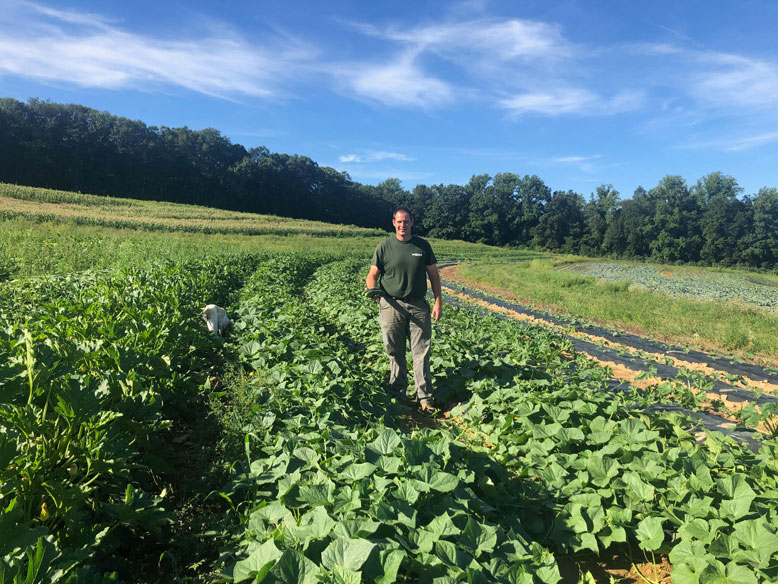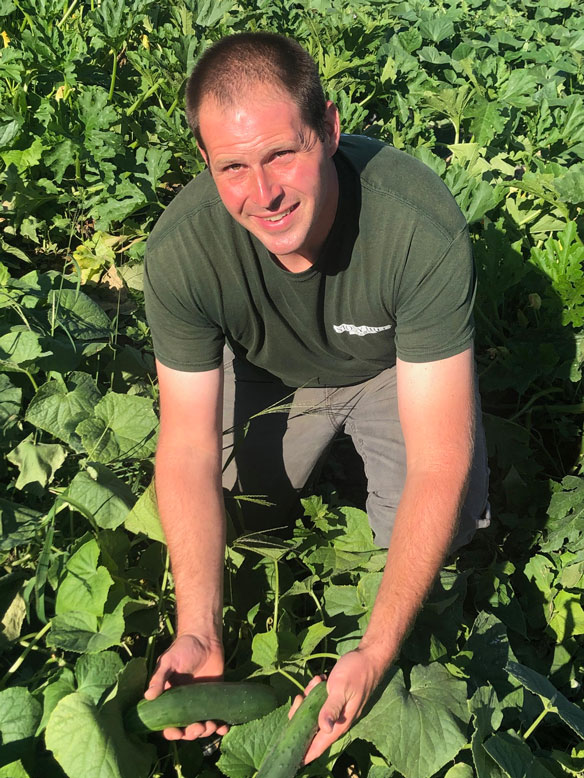
Cucumbers are among New Jersey’s top 10 most valuable crops, with the Garden State growing over 60 million pounds annually on 3,100 acres—with nearly half of those cucumbers being grown in Gloucester County. Out of all the cucumbers grown in the U.S., New Jersey produces nearly 10 percent of them.
I’ve always enjoyed cucumbers, which are a mild, refreshing, and crunchy adder to salads, sandwiches, stir-fries and drinks. High in antioxidants and vitamins C and K (the latter of which assists in the blood-clotting process), cucumbers are also filling and aid in hydration since they’re made up of over 95% water, which renders them a perfect treat all year-round, but especially in the hot, dog days of late summer.

Farmer Dale Davis poses in his field of cucumbers at Stony Hill Farms in Chester. Photo courtesy of Stony Hill Farms
The Lowdown on Cucumbers
Though commonly thought to be a vegetable, the cucumber is a member of the Cucurbitaceae family (along with squash and certain kinds of melon) and is actually a fruit. Cucumbers are usually cylindrical in shape and range from about six to nine inches in length. The skin of the cucumber can vary in color from green to white and may be smooth or ridged depending on the variety. Underneath the cucumber skin is pale green flesh that’s thick yet aqueous and crispy at the same time, while the interior core of the cucumber has numerous edible fleshy seeds.
There are hundreds of varieties of cucumber and they come in dozens of colors, but the edible types are classified as being for either slicing or pickling. Slicing cucumbers are grown to be eaten fresh, while pickling cucumbers are intended for the brine jar. Slicing cucumbers are usually larger and thicker-skinned than pickling ones.
Fun Facts About Cukes
— An average-sized cucumber has less than 50 calories.
— Thanks to their anti-inflammatory properties, some people use cucumber to soothe sunburn or reduce puffiness in their skin or around their eyes.
— Green cucumbers are actually the unripened variation. Ripe cucumbers are actually yellow and have a bitter taste.
— The phrase “cool as a cucumber” is no lie—the inside of a cucumber can be 20 degrees cooler than the temperature of its outer skin.
— Because they have such cooling properties, sliced cucumbers are often sold on sunny afternoons in India.
— The biggest recorded cucumber, grown in southern China, was 67 inches long and weighed 154 pounds.

Farmer Dale Davis shows how cucumbers at Stony Hill Farms grow in the ground under a canopy of leaves. Photo courtesy of Stony Hill Farms
Fresh from the Farm
At 500-acre, family-owned Stony Hill Farms in Chester, farmer Dale Davis knows a thing or two about cucumbers. “We grow 4 to 5 acres of cucumbers and sell tens of thousands of them over the season,” he says. “The first cucumbers come out of South Jersey in late June/early July and then we’re picking ours every other day from mid-July through the end of October.” Beginning in early May, cucumbers are planted every 14 days to ensure a steady crop over the season. Given that cucumbers take about 70 days to mature, “we end up doing about 10-12 plantings each season and harvest anywhere from 20 to 30 50-pound crates full of cucumbers at a time,” he says, noting that cucumber vines that aren’t regularly harvested will stop producing.
Among the varieties it offers, Stony Hill Farms grows two pickling types of cucumbers and two slicing types. According to Davis, “some farmers grow cucumbers along four-foot-high steel trellises, an approach which allows them to harvest more cucumbers from fewer plantings.” By contrast, he says, “we grow our cucumbers in the ground, where a canopy of leaves keeps them shaded.”
Davis confirms that September is a great time for New Jersey produce because so many delicious items are coming to maturity at once, including cucumbers. “Cukes can be used in a lot of ways—in salads, spiralized, as a garnish for drinks—and we sell tons of them,” he says. “They’re a great complement to so many dishes and September is definitely the time to indulge in this fresh, cool fruit.”
Selection, Storage, and Preparation

Produce Pete discusses how cucumbers are grown during a recent field segment on NBC Weekend Today in New York. Photo courtesy of Pete Napolitano/NBC
Simply put, the darker the cuke, the better (except for the Kirby variety, which is naturally very pale). Cucumbers should be long and slender. It’s best to stay away from the jumbo size, as they’ll be mostly seeds. Avoid soft, withered-looking, or yellow cukes (the belly of the cuke goes yellow first), which are more likely to be bitter. I like cucumbers right off the farm because they’re usually unwaxed and all you need to do before eating them is rinse them under cold water. (Waxed cucumbers are often coated with vegetable oil, which prevents them from drying out when they’re shipped from other states). Keep cucumbers in a plastic bag in the fridge for about a week, especially those purchased at a farmers’ market, because they don’t have a wax coating and can lose moisture faster.
Cucumbers are great eaten raw in salads, on sandwiches, or with hummus or other dips and have also become a refreshing component in infused waters as well as a popular garnish for certain alcoholic drinks. You can also pickle the cucumbers using either a shorter slicing or a pickling cucumber.
One of our favorite neighbors, Lorraine Nicolini, always wowed my wife Bette and I with her delicious recipe for bread and butter pickles, which she made fresh from thinly-sliced cucumbers. I know you’ll enjoy it too!
Lorraine’s Famous Refrigerator Bread N Butter Pickles
Ingredients:
5½ cups (approximately 1½ pounds) cucumbers, thinly-sliced
1½ tablespoons kosher salt
1 cup sweet onions, thinly-sliced
2 cups granulated sugar
2 cups white vinegar
1 cup apple cider vinegar
½ cup light brown sugar
3 teaspoons mustard seeds
1 teaspoon celery seeds
¼ teaspoon ground turmeric
Instructions:
Combine cucumbers and salt in a large bowl, then cover and chill for 1½ hours. Move to a colander and rinse them thoroughly with cold water. Drain well and return cucumbers to the bowl, then add onions to the bowl and toss. Combine both sugars, both vinegars, mustard seeds, celery seeds, and turmeric in a medium saucepan and bring to a simmer over medium heat until sugar dissolves. Prep canning jars in a large pot and bring to a boil. Remove them from the water and add the cucumbers and onions to the jars. Pour the hot vinegar/sugar pickling liquid over the cucumbers. Cover and refrigerate for 24 hours before eating. Best if used within 1 month.
About “Produce Pete” Napolitano
With over 65 years of experience in the produce industry, New Jersey’s own “Produce Pete” Napolitano is a renowned fruit and vegetable expert, author, and television personality who’s appeared on a highly-popular segment on NBC’s Weekend Today in New York broadcast every Saturday mornings for over 27 years. For more information, visit Pete’s website.
About Susan Bloom
A contributor to New Jersey Monthly and a variety of other well-known local and national publications, Susan Bloom is an award-winning New Jersey-based freelance writer who covers topics ranging from health and lifestyle to business, food and more. She’s collaborated with Produce Pete on a broad range of articles for nearly a decade.
